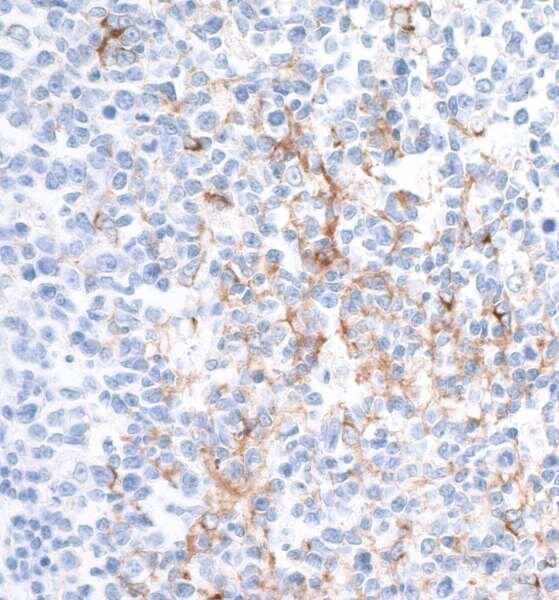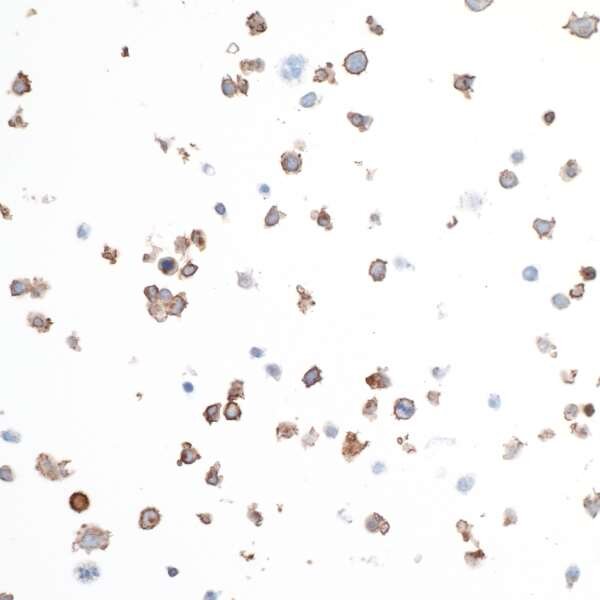In-Depth with CD137
CD137, also known as 4-1BB, ILA, and TNFRSF9, is a member of the TNF family that was originally identified through genetic screens as being expressed on activated T cells.1 CD137 is expressed on transitional CD45RA+ CD45RO+ T cells.2 and activated CD8+ and CD4+ T cells3,4 It can be used as a marker for CD8+ T cells that are antigen-experienced. CD137 can also be expressed on dendritic cells, where ligation promotes cell survival and activation, and increases the duration of contact between dendritic cells and T cells.5,6
Signaling through CD137 on T cells with its ligand, 4-1BBL or TNFSF9, expressed on professional antigen presenting cells including B cells, dendritic cells, and macrophages.7 results in increased proliferation, increased secretion of IL-2 and interferon gamma, and a greater capacity to kill target cells4 4-1BBL can also be expressed on T cells, and interact with CD137 on the surface of the same cell to promote an immunoregulatory T cell phenotype.8 Outside of the canonical antigen presenting cell-T cell axis, CD137 has also been observed to be expressed on NK cells, NKT cells, and gamma delta T cells in the immune compartment, and endothelial cells, neural cells and osteoclasts.9
CD137 is implicated in many disease processes. Its widespread expression in the tumor microenvironment makes CD137 an optimal target for therapy, while its expression on cells throughout the body may also lead to adverse side effects. An early clinical study of patients with HIV indicated that a higher frequency of CD8+ T cells isolated from these patients express CD137 than CD8+ T cells isolated from healthy donors. Crosslinking of CD137 on CD4+ T cells from HIV+ donors increased replication of the HIV virus10 despite an increased level of cell surface CD137 being associated with antiretroviral treatment and a decrease in viral burden.11
In the cancer setting, CD137 is expressed on the surface of many human tumor cell lines and primary tumors including cervical cancer, colon cancer, rectal cancer, and lung cancer.12,13 In the tumor microenvironment, CD137 expression was predominantly found on the vasculature.13 Because of its pervasive expression across tumor cell types, CD137 is a target of immunotherapy for cancer.14 It was first elucidated as such when it was observed that agonistic antibodies against CD137, which activate CD8+ and CD4+ T cells in the tumor microenvironment, could eradicate both poorly and highly immunogenic tumors in a mouse model15. Since then, agonistic antibodies targeting 4-1BB has proven effective as an adjuvant therapy to dendritic cell vaccines,16,17 IL-12-based gene therapy18, and chemotherapy19 for the treatment of a variety of murine tumor models including B16-F10 melanoma, MC38 colon carcinoma, and the renal cancer model Renca. Numerous clinical trials exploring the efficacy of targeting CD137 in combination with other checkpoint blockade therapies have been investigated; however, many were terminated due to adverse events including liver inflammation and neutropenia.9,20,21 The efficacy of lowering the dose of anti-CD137 antibody, and the combination with other checkpoint blockade therapies, is under investigation.
References
- Kwon BS, Weissman SM (1989) cDNA sequences of two inducible T-cell genes. Proc Natl Acad Sci U S A 86:1963–7 . doi: 10.1073/PNAS.86.6.1963
- Garni-Wagner BA, Lee ZH, Kim Y-J, et al (1996) 4-1BB Is Expressed on CD45RAhiROhiTransitional T Cell in Humans. Cell Immunol 169:91–98 . doi: 10.1006/cimm.1996.0095
- Wölfl M, Kuball J, Eyrich M, et al (2008) Use of CD137 to study the full repertoire of CD8+ T cells without the need to know epitope specificities. Cytometry A 73:1043–9 . doi: 10.1002/cyto.a.20594
- Wen T, Bukczynski J, Watts TH (2002) 4-1BB ligand-mediated costimulation of human T cells induces CD4 and CD8 T cell expansion, cytokine production, and the development of cytolytic effector function. J Immunol 168:4897–906
- Choi BK, Kim YH, Kwon PM, et al (2009) 4-1BB Functions As a Survival Factor in Dendritic Cells. J Immunol 182:4107–4115 . doi: 10.4049/jimmunol.0800459
- Futagawa T, Akiba H, Kodama T, et al (2002) Expression and function of 4-1BB and 4-1BB ligand on murine dendritic cells. Int Immunol 14:275–286 . doi: 10.1093/intimm/14.3.275
- Futagawa T, Akiba H, Kodama T, et al (2002) Expression and function of 4-1BB and 4-1BB ligand on murine dendritic cells. Int Immunol 14:275–86
- Eun S-Y, Lee S-W, Xu Y, Croft M (2015) 4-1BB ligand signaling to T cells limits T cell activation. J Immunol 194:134–41 . doi: 10.4049/jimmunol.1401383
- Bartkowiak T, Curran MA (2015) 4-1BB Agonists: Multi-Potent Potentiators of Tumor Immunity. Front Oncol 5:117 . doi: 10.3389/fonc.2015.00117
- WANG S, KIM Y-J, BICK C, et al (1998) The Potential Roles of 4-IBB Costimulation in HIV Type 1 Infection. AIDS Res Hum Retroviruses 14:223–231 . doi: 10.1089/aid.1998.14.223
- Kassu A, D’Souza M, O’Connor BP, et al (2009) Decreased 4-1BB expression on HIV-specific CD4+ T cells is associated with sustained viral replication and reduced IL-2 production. Clin Immunol 132:234–245 . doi: 10.1016/j.clim.2009.03.531
- Zhang G-B, Dong Q-M, Hou J-Q, et al (2007) Characterization and application of three novel monoclonal antibodies against human 4-1BB: distinct epitopes of human 4-1BB on lung tumor cells and immune cells. Tissue Antigens 70:470–479 . doi: 10.1111/j.1399-0039.2007.00943.x
- Wang Q, Zhang P, Zhang Q, et al (2008) Analysis of CD137 and CD137L expression in human primary tumor tissues. Croat Med J 49:192–200 . doi: 10.3325/CMJ.2008.2.192
- Vinay DS, Kwon BS (2014) 4-1BB (CD137), an inducible costimulatory receptor, as a specific target for cancer therapy. BMB Rep 47:122–9 . doi: 10.5483/BMBREP.2014.47.3.283
- Melero I, Shuford WW, Newby SA, et al (1997) Monoclonal antibodies against the 4-1BB T-cell activation molecule eradicate established tumors. Nat Med 3:682–5
- Tirapu I, Arina A, Mazzolini G, et al (2004) Improving efficacy of interleukin-12-transfected dendritic cells injected into murine colon cancer with anti-CD137 monoclonal antibodies and alloantigens. Int J Cancer 110:51–60 . doi: 10.1002/ijc.20093
- Cuadros C, Dominguez AL, Lollini P-L, et al (2005) Vaccination with dendritic cells pulsed with apoptotic tumors in combination with anti-OX40 and anti-4-1BB monoclonal antibodies induces T cell-mediated protective immunity in Her-2/neu transgenic mice. Int J Cancer 116:934–943 . doi: 10.1002/ijc.21098
- Xu D, Gu P, Pan P-Y, et al (2004) NK and CD8+ T cell-mediated eradication of poorly immunogenic B16-F10 melanoma by the combined action of IL-12 gene therapy and 4-1BB costimulation. Int J Cancer 109:499–506 . doi: 10.1002/ijc.11696
- Ju S-A, Cheon S-H, Park S-M, et al (2008) Eradication of established renal cell carcinoma by a combination of 5-fluorouracil and anti-4-1BB monoclonal antibody in mice. Int J Cancer 122:2784–2790 . doi: 10.1002/ijc.23457
- Ascierto PA, Simeone E, Sznol M, et al (2010) Clinical Experiences With Anti-CD137 and Anti-PD1 Therapeutic Antibodies. Semin Oncol 37:508–516 . doi: 10.1053/j.seminoncol.2010.09.008
- Chester C, Ambulkar S, Kohrt HE (2016) 4-1BB agonism: adding the accelerator to cancer immunotherapy. Cancer Immunol Immunother 65:1243–8 . doi: 10.1007/s00262-016-1829-2

